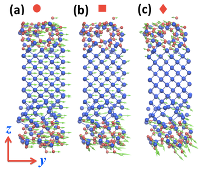Native surface oxide turns alloyed silicon membranes into
nanophononic metamaterials with ultralow thermal conductivity
Shiyun Xiong, Daniele Selli, Sanghamitra Neogi, and Davide Donadio,
Phys. Rev. B, 95, 180301(R) (2017)
Native oxide layers couple with phonons in ultrathin silicon membranes through local resonances to hinder in-plane phonon transport
